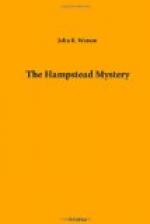“We’ll go with you,” said Inspector Chippenfield, speaking for Rolfe and himself. He did not understand how Crewe expected to obtain any evidence at Riversbrook about the truth or falsity of Kemp’s story, but he did not intend to admit that. “But you can set your mind at rest. No jury will believe Kemp after we’ve given them his record in cross-examination.”
Rolfe, whose association with Crewe in the case had awakened in him a keen admiration for the private detective’s methods and abilities, permitted himself to defy his superior officer to the extent of saying that “the best way to prove Kemp a liar is to prove that his story is false.”
During the drive to Hampstead from the Old Bailey the three men discussed Kemp and his past record. It was recalled that less than twelve months ago, while he was serving three years for burglary, his daughter had provided the newspapers with a sensation by dying in the dock while sentence was being passed on her. According to Inspector Chippenfield, who had been in charge of the case against her, she was a stylish, good-looking girl, and when dressed up might easily have been mistaken for a lady.
“She got in touch with a flash gang of railway thieves from America,” said Inspector Chippenfield, helping himself to a cigar from Crewe’s proffered case. “They used to work the express trains, robbing the passengers in the sleeping berths. She was neatly caught at Victoria Station in calling for a dressing-case that had been left at the cloak room by one of the gang. Inside the dressing-case was Lady Sinclair’s jewel case, which had been stolen on the journey up from Brighton. The thief, being afraid that he might be stopped at Victoria Station when the loss of the jewel case was discovered, had placed it inside his dressing-case, and had left the dressing-case at the cloak room. He sent Dora Kemp for it a few days later, as he believed he had outwitted the police. But I’d got on to the track of the jewels, and after removing them from the dressing-case in the cloak room I had the cloak room watched. When Dora Kemp called for the dressing-case and handed in the cloakroom ticket, the attendant gave my men the signal and she was arrested.”
“She died of heart disease while on trial, didn’t she?” asked Crewe.
“Yes,” replied Inspector Chippenfield. “Sir Horace Fewbanks was the judge. He gave her five years. And no sooner were the words out of his mouth than she threw up her hands and fell forward in the dock. She was dead when they picked her up.”
“She was as game as they make them,” put in Rolfe. “We tried to get her to give the others away, but she wouldn’t, though she would have got off with a few months if she had. The gang got frightened and cleared out. They left her in the lurch, but she wouldn’t give one of them away.”
“It was Holymead who defended her,” said Chippenfield. “It was a strange thing for him to do—leading barristers don’t like touching criminal cases, because, as a rule, there is little money and less credit to be got out of them. But Holymead did some queer things at times, as you know. He must have taken up the case out of interest in the girl herself, for I’m certain she hadn’t the money to brief him. And I did hear afterwards that Holymead undertook to see that she was decently buried.”




